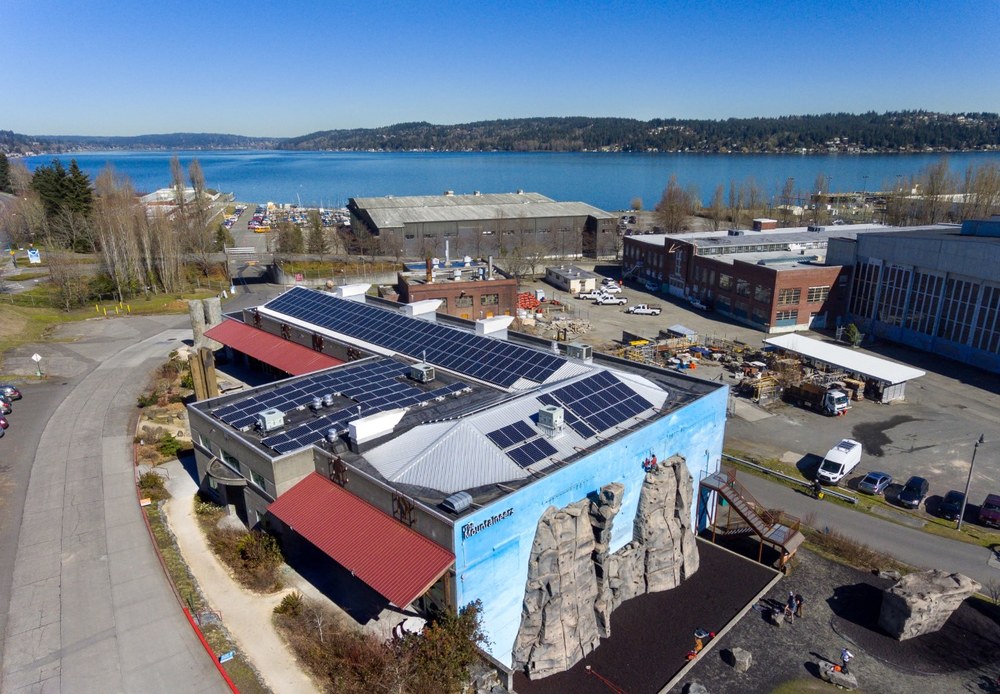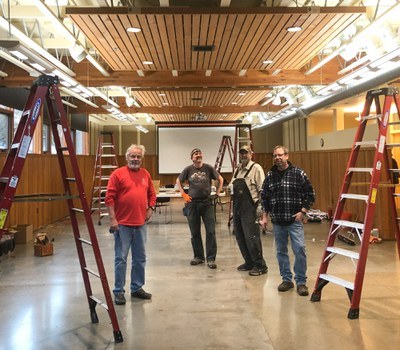
As we experience worsening impacts of the climate crisis on our public lands and communities, we must do more to respond to this urgent threat.
In 2017, The Mountaineers committed to intentionally addressing the climate crisis by making carbon footprint reduction a priority in our Vision 2022 strategic plan. As our climate statement outlines, we intend to do our part to secure a more sustainable climate future by educating the outdoor community, advocating for public lands protections, reducing our organizational carbon footprint, and publishing books that promote climate solutions and sustainability.
We’ve already made great progress on reducing our organizational carbon footprint through energy-reduction projects at our facilities and in our programs and operations. Tangible examples include the installation of solar panels on the Seattle Program Center, converting from natural gas/propane to heat pumps at the Tacoma Program Center and Stevens Lodge, and converting from incandescent to LED lights at all our facilities. However, the urgency of the climate crisis demands that we do more.
Announcing our Goal to Become a Net Zero Organization
As an organization that cares deeply about healthy lands and waters, The Mountaineers has a unique obligation to aggressively reduce our impact on the environment. While we do that through our public lands advocacy, stewardship, and low-impact recreation practices, we still emit thousands of pounds of greenhouse gas emissions through our operations. Throughout the development of our new strategic plan, Adventure with Purpose, we consistently heard from volunteers and donors that we need to make faster progress toward reducing our organization’s carbon footprint.
We’re thrilled to announce that The Mountaineers has committed to the ambitious goal of achieving net zero carbon emissions from direct organizational impacts. Net zero means cutting greenhouse gas emissions to as close to zero as possible, with any remaining emissions reabsorbed from the atmosphere by oceans, forests, or other carbon offsets. Achieving this goal is attained both by converting to power sources such as solar and reducing our energy consumption through efficiency efforts.
Direct organizational impact is sometimes called “scope 1 emissions” and refers to the net consumption of greenhouse gasses from sources that are directly controlled by an organization. For The Mountaineers, this refers to things such as lighting, heating, and cooling our owned and leased buildings and operating vehicles. It also involves minimizing the footprint of operations such as our publishing division. Scope 1 emissions exclude indirect impacts such as the carbon footprint of members driving to activities and events, or the gear people use to participate in courses and field trips. The way we’ve approached net zero as an organization includes replacing natural gas heating with electric heat pumps, outfitting our buildings with solar energy, and installing energy-efficient lighting and appliances.
We’ll be honest: achieving net zero for direct organizational impacts is the type of audacious goal that makes us excited but also nervous. The finish line is likely years away, and we have a lot of work to do to establish the scope and timeline for this goal. If the current leadership demonstrated by Mountaineers volunteers and donors is any indication of the future, it is clear our community is already rising to the challenge. And we deeply believe that striving for a bold goal such as this is important to demonstrating leadership and “walking the talk” on climate.
If you’re inspired to invest your time, expertise, or dollars toward the goal of becoming a net zero organization, we’d love to hear from you.
MOUNTAINEERS VOLUNTEERS DAN RITTER, DAVE SHULTZ, BRUCE DURHAM, AND TOM CARROLL RETROFITTING THE TPC WITH LED LIGHTS. PHOTO BY CHARLIE MICHEL.
Completed Carbon Footprint Reduction Projects
Thanks to community programs and support from our members, including our Carbon Footprint Reduction Committee, we’ve begun to address the carbon footprint of our facilities through several energy-reduction projects at our Seattle and Tacoma Program Centers, as well as at our lodges. Read on to learn more about the work that’s already been done and what remains to get us toward net zero.
Seattle Program Center
The effort to reduce the carbon footprint of Mountaineers buildings gained significant momentum in 2018 when members Charlie and Carol Michel made a large philanthropic investment to install solar panels at the Seattle Program Center. A new system that includes 271 solar panels and two inverters was installed in January 2019 and produces more energy than the building consumes in a given year. Thanks to our volunteers, we’ve also retrofitted all of the lighting with energy-efficient LEDs, installed new occupancy sensors that save energy, and installed new energy-efficient appliances.
Tacoma Program Center
In 2021, we announced the Tacoma Net Zero Energy Project. This project included three phases: lighting, energy-efficient appliances, and installation of solar panels. The first two phases are complete, and after solar panels are installed in early 2023, the Tacoma Program Center (TPC) will be a net zero facility. Read more about how volunteers and donors made this project possible in the spring edition of Mountaineer magazine released in March.
Mountaineers Lodges
Energy upgrades aren’t just a priority for our program centers. Our dedicated volunteers have already funded and implemented some important energy upgrades at Mountaineers lodges, including the installation of heat pumps at Stevens Lodge and converting to LED lighting at all three of our lodges. The long-range plan for Stevens Lodge also includes replacing the commercial propane cook stove with an equivalent electric appliance. Carbon footprint reduction will be front-of-mind as we embark on capital improvements for our lodges in the years ahead.
Mountaineers Publishing
We’re working to reduce the carbon footprint and environmental impact of Mountaineers Books by consistently investing in 100% recycled, post-consumer, and FSC-certified paper for new titles, and updating reprints whenever possible. We prioritize domestic and on-shore manufacturing with our maps, catalogs, and calendars printed as close as Olympia. Beyond the publishing program, we’ve also reduced the footprint of daily operations by replacing the lights at The Mountaineers Books offices and warehouse with LEDs. Mountaineer magazine is also printed on 100% recycled and FSC-certified paper, and there are additional plans to further reduce the carbon footprint of the organization’s operations.
What’s Next for Carbon Footprint Reduction?
Reaching net zero carbon emissions at our Seattle Program Center (SPC) will allow us to save about 7,260 therms of natural gas and 85,000 lbs of CO2 from being emitted into the atmosphere a year. This carbon offset is equivalent to taking eight gas-powered cars off the road each year. With additional resources, we can make important progress toward our net zero goal through these future energy-reduction projects at our Seattle Program Center.
Heat Pumps
Topping our list of next projects to be funded is the installation of heat pumps to heat and cool the Seattle Program Center. There is currently no air conditioning in the SPC’s Goodman or Cascade conference rooms. These heat pumps will replace natural gas heating units on the roof, along with the current air conditioning units. The eight heat pumps needed for this project will yield 53 tons of total cooling capacity and full air conditioning for the Goodman and Cascade conference rooms.
Saving Energy Through Temperature Control
The Seattle Program Center’s current ventilation system leads to wasted heat and cool air. Incoming fresh air now must be heated (or cooled) from ambient outside temperature to the room temperature using natural gas. Installing four Energy Recovery Ventilators (ERVs) to replace the current roof dampers will save energy to maintain the building’s temperature. ERVs are heat exchangers that transfer the heat (or cool) from the stale air to fresh, incoming air and warms it before it is discharged to the room.
Hot Water
Installing new heat pump hot water heaters will more efficiently power the Seattle Program Center’s bathrooms and linen laundry room. This upgrade will likely double or triple the energy efficiency of the basement’s existing electric heating.
Completing these future energy reduction projects will go a long way toward achieving net zero for the Seattle Program Center. We’re still working to identify additional opportunities to reduce our organizational carbon footprint at our facilities and in our operations. This will likely include efforts to further reduce energy consumption at Mountaineers lodges and in other aspects of our operations.
How You Can Help Us Achieve Net Zero
We wouldn’t have achieved this early progress without the time, expertise, and generous gifts from Mountaineers across our branches and activities. Last fall we created a new Carbon Footprint Reduction Fund to support our ongoing work to reduce our collective carbon footprint. We’ve secured $100,000 in investments to kick-start this strategic goal with a donation from Charlie and Carol Michel matched by The Mountaineers Board of Directors. We’ll also continue to seek additional sources of funding, including government grants, rebates, and tax incentives.
Philanthropic investment from our members will be critical to fund ongoing efforts to reduce The Mountaineers carbon footprint. If you’re inspired to help us reach our goal of net zero carbon emissions, we hope you’ll consider a donation to our Carbon Footprint Reduction Fund.
Add a comment
Log in to add comments.I'm really happy to see the Mountaineers set their sites on being a net zero organization. It's a big goal, but we don't shy away from big goals.
 The Mountaineers
The Mountaineers
